Atelier Bonryu(E)
infrared photography


Atelier Bonryu(E)
infrared photography


Laboratory Infrared Photography
IV.Lensless Infrared Photography
4-1 Problems of Lensless Infrared Photography
Cameras for Lensless and Invisible Light Photography: Both a lensless photograph and an invisible light photograph are attractive with unique features nonexistent in a conventional photograph. Then, how do they look when they are combined? One of the difficult points is that very long exposure time is necessary for both the lensless photography and the infrared photography to take by an non-converted camera as described previously. To take a lensless photograph by a digital camera the camera should be one with interchangeable lenses and at the start for the experiment of the lensless infrared photography I employed Olympus E-300. Admitting that this camera has higher sensitivity to infrared lights it may be rather difficult to take a lensless infrared photograph by an non-converted camera because the necessary multiplication factor of exposure for the infrared photography by this camera is around 300. The result of this experiment was not good enough. However, as recent mirrorless SL camera is equipped with a sensor of considerably high sensitivity I tried to take a zone plate infrared photograph by using a converted mirrorless SL camera, Olympus E-M5. Then the result has been improved considerably. The method and some results of the experiment to take an infrared lensless photograph are described in the following.
Conditions for Zone Plate: As for the zone plate used for the lensless infrared photography the following two points should be considered.
(1) Transparency of Film to Infrared Light: At first, it should be checked whether the film-based zone plate used for the visible light zone plate photography can be used or not also for the infrared photography. As long as we look at the opaque zone on the film by visible lights it looks black and it blocks visible lights. However, the visibly opaque zone might transmit infrared lights in some degree rather completely. As I couldn’t find out any quantitative data on transmission factor of infrared lights through the film I investigated the transmission factor qualitatively by using the infrared light from a remote control unit of a TV set (a wavelength of about 950 nm). For this investigation I used a point-and-shoot camera, Olympus mu Digital 800 and took photographs of the window of the remote controller emitting the infrared light by inserting the exposed film (micro-film used for making a zone plate), Fujifilm IR76 filter, Marumi UV-IR cut filter between the light source and the camera. Even when the film is inserted the infrared light is recorded but the intensity is considerably reduced (Fig.4-1(f)). It is also confirmed from these photographs that the UV-IR cut filter is transparent to visible lights and opaque to infrared lights, and the IR76 filter is opaque to visible lights and transparent to infrared lights. From this result it may be concluded that a film-based zone plate made of a micro-film can be used and I decide to use it for taking a lensless infrared photograph.
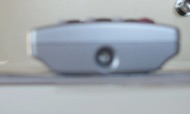
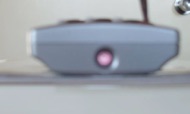

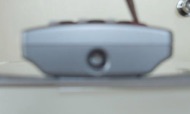
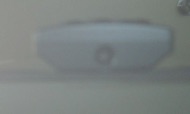
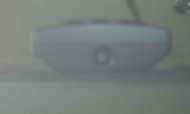
(a)
(b)
(c)
(d)
(e)
(f)
Fig.4-1 Qualitative estimation of transmission of infrared lights through various filters and an exposed micro-film by taking photographs of a remote controller of a TV set by Olympus mu Digital 800. (a), (b): no filter, (c): Fujifilm visible cut- IR transparent filter IR76, (d): Marumi UV-IR cut filter, (e), (f): exposed micro-film, (a), (e): light off, others: light on.
(2) Focal Length of Zone Plate for Infrared Light: Second problem is that the zone plate described up to now is for the visible light and designed for the wavelength of 550 nm. As the wavelength of the infrared light is far longer than this value, the pattern size of the zone plate should be changed. As we employed the wavelength of 550 nm for the representative wavelength of the visible light we decide the wavelength of the infrared light as 800 nm for convenience sake. If we are to design a zone plate with the same focal length and the same zone number the radius of the outermost zone becomes large by 800/550. On the other hand if we use the same zone plate used for the visible light photography the focal length becomes short by 550/800. For example, when we use a zone plate with the focal length of 150 mm designed for the visible light photography with the wavelength of 550 nm, this zone plate works as a zone plate with the focal length of 103 mm for the infrared photography with the wavelength of 800 nm (Fig.4-2).




Complete Guide to Digital
Infrared Photography
(English Edition)
Handbook of
False Color Infrared Photography
(Japanese Edition)
Complete Guide to
Zone Plate Photography
(Japanese Edition)

Fig.4-2 Difference of the focal length for different wavelength
A zone plate with the focal length of 150 mm for the wavelength of 550 nm works as a zone plate with 103 mm for the wavelength of 800 nm.
